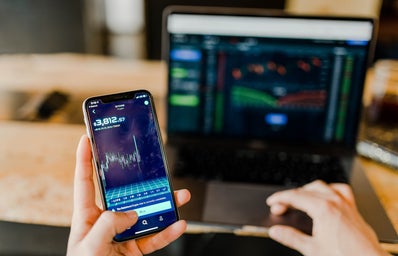Since the inception of the modern stock exchange, the term ‘stock’ has been enough to trigger feelings of stress, anxiety and extreme disinterest. Its impact on people is similar to that of the questions, “What are your plans for the future?” or “Is everyone ready for breakout rooms?”
Nevertheless, investing has become more digestible and comprehensible with mandatory finance classes, get-rich-quick schemes, and ‘stonks’ memes. Regrettably, this has lured most of us into a false sense of security: just like the Covid-19 variants, as soon as we gained a peripheral understanding of the stage one finance bro, a second stage emerged: the crypto bro.
If you thought the term ‘stock’ was fear-inducing, the terms ‘blockchain,’ ‘NFTs,’ and ‘crypto’ are enough to trigger our fight-or-flight response. With complex computer codes and personalized addresses, your identity on the blockchain is simplified to a 24-36 alphanumeric code. It’s a decentralized digital currency, meaning that neither you nor the government can control or regulate it. Because of this, some consider it to be the future of the global economy; it ensures that transactions are secure, preventing the potential for fraud and institutional corruption. Whether you believe any of this to be true, it’s essential to understand what it is, how it works and how it could impact you.
The following list explains basic terminology related to blockchain technology:
Account/wallet – A 24-36 digit code that represents an identity on the blockchain. If you want to own cryptocurrency, you’ll need to create an account/wallet.
Block – Each block displays three pieces of information: a timestamp of when it was created, a hash of the previous block and a piece of transaction data. This allows users to view the transaction history of every block on the blockchain, ensuring that each one is real.
Blockchain – A linkage of multiple blocks that functions as a communal ledger (a ledger used by many people).
Centralized – In crypto, “centralized” refers to systems of government or systems of control that are operated by specific groups. An example of this would be the banking system: although we all use the banking system, it’s controlled by the bank and its owners.
Coin – The original currency on a blockchain (also called a native coin). For the Bitcoin chain, the native coin is Bitcoin. For the Ethereum chain, the native coin is Ether.
Cryptocurrency – The currency used on the blockchain. Just like the Canadian dollar is used in Canada, cryptocurrency is used on the blockchain.
Currency – A form of value generally accepted within a group of people. An example of this is the Canadian dollar (CAD).
Decentralized – In crypto, “decentralized” refers to systems that are operated by many individuals. Bitcoin is not owned or operated by a single group; instead, it’s controlled by millions of Bitcoin users all over the world.
Ethereum – Ethereum is the second-largest blockchain, and while its native (original) token is Ether, anyone can create a new token on it.
Fiat currency – Currencies that are tied to governments, not commodities. For example, the US Dollar (USD) was initially connected to the amount of gold the country had (each coin represented the trading of gold). The US has removed its dollar from the gold standard, and it’s instead based on the strength of the country itself (a fiat currency).
Hash – An alphanumeric sequence that individually identifies each block.
Key – Each wallet has two keys: a public one and a private one. Your public key allows you to receive cryptocurrency from other people’s wallets, just like how your email address permits you to receive e-transfers. Your private key allows you to access your wallet, just like how your online banking username and password will enable you to deposit the e-transfer.
Ledger – A system to record transactions. Whenever you look up your order history on the Starbucks app, you’re referencing a ledger.
Non-fungible token (NFT) – A token that is unique (non-fungible). An example of a fungible token would be a loonie. Each loonie is interchangeable: my loonie is no different than yours.
Smart contracts – Pieces of code that perform specific actions when different criteria are met. For example, on a stock market, if a company goes public (lists their shares on the market), there may be certain rules, such as that the owners are not allowed to sell the stock for 3 months. These rules are enforced by the SEC and the US Government. Since blockchain is decentralized, it enforces these rules using a smart contract. If a smart contract specifies that a person can’t sell their shares for x amount of time, then it will automatically prevent them from selling their shares before x amount of time. Once smart contracts are created, they cannot be changed (they are immutable).
Token – Some blockchains can support multiple forms of currency (like an international bank). Currencies that are not native coins are called tokens. An example of this would be the Shiba Inu token ($SHIB) built on the Ethereum blockchain.
__coin (bitcoin, dogecoin, etc.) – These are tokens that run on blockchain ledgers. If a blockchain was your favourite store, then the tokens would be a gift card: they represent real money but can only be used at that store. Some blockchains can have multiple tokens, while others (i.e. Bitcoin) are singular.
Next steps
If you want to get involved, I suggest taking an online course or reading an online guide; buying and trading cryptocurrency is much more complex than buying and trading stocks. Numerous Youtube videos explain blockchain terminology in further detail.
In terms of blockchain-related fads, many people have jumped on the NFT craze, where individuals will spend millions of dollars on virtual pictures of Monkeys, GIFs or online artwork. While it’s uncertain where these items will stand in the future, they’re extremely volatile and risky (in other words, not a secure investment). However, NFTs are not useless: their technology can be used to guarantee contracts, from mortgages and lines of credit to phone plans and Netflix subscriptions.
In the future, we could see blockchain and cryptocurrency be integrated into our current financial systems. Yet while many believe that cryptocurrencies can replace global banking systems, this is not the case (at least in the near future). Cryptocurrency and blockchain technology will likely operate in tandem with current global systems to increase security, lower costs, boost efficiency and maintain accountability. Cryptocurrency is the only way to anonymously transact globally while still having your transactions recorded in a ledger. Since every transaction is recorded if banking systems switched to cryptocurrency, there would no longer be cases of governments stealing money from civilians.
TL; DR: To intimidate a crypto bro, threaten to screenshot their NFT.
While many people can define the verbiage used in relation to this topic, it’s crucial to understand how these technologies can impact your life without being susceptible to “get rich quick” scams. To learn how to get involved with cryptocurrency and blockchain, you should definitely buy a book or read one of the many online guides. Just like the internet was perceived in the late 1990s, many believe that cryptocurrency is simply a way of selling drugs or laundering money that will be used by the dark web to secretly perform illicit data transactions. However, it may not be long before every aspect of personal finance, data security, social media interactions, and job settings will be conducted on the blockchain.


